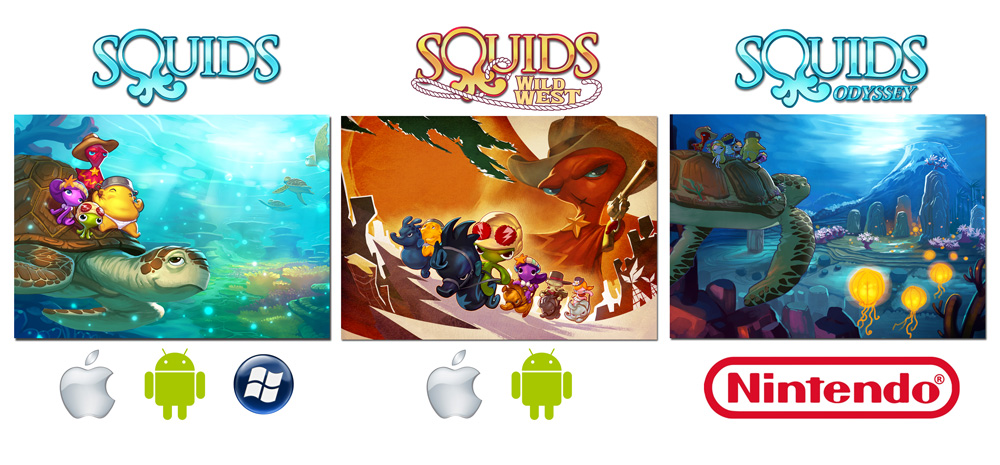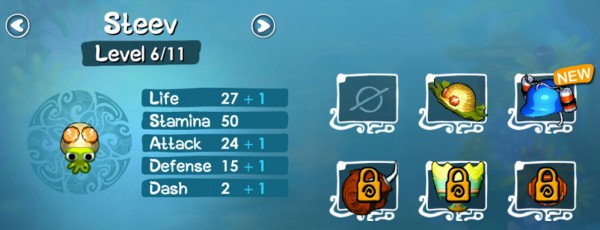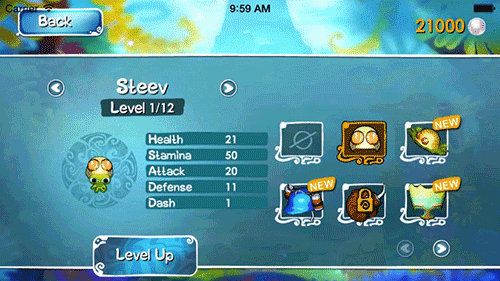Squids origins and design
SQUIDS was our first game as The Game Bakers, and since its initial release on iOS in 2011, it has lived a good life. It was ported to other platforms (Android and Windows Phone, PC, Mac), had a critically-acclaimed sequel (SQUIDS Wild West, 87% average on Metacritic), and was recently released on Wii U and 3DS in the form of SQUIDS Odyssey, which compiles the first two SQUIDS games with a new chapter and a lot of bonus content.

I’ve already discussed the business and financial side of the game in a previous article, and in another one, the fact that the game was developed « in the clouds » with team members all over the world. Now that SQUIDS Odyssey is generating new interest in the franchise, I want to delve into why and how we made some our design decisions, when we first conceived SQUIDS.
Like most ideas at The Game Bakers, SQUIDS was born at the diner table. The Game Baker’s co-founder Audrey Leprince and I were discussing our mutual passion for octopus, squid and calamari, and what incredible creatures they are. (Not only because they’re tasty!) After a few glasses of wine, we started having fun with the idea of a game called « Assassin’s Squid ». It was a good pun but normally this wouldn’t have been a conversation I’d still be thinking about the next morning. This time, though, the idea stuck in my head for a reason I couldn’t identify at the time.
I had been trying to come up with a new game idea for a while. I knew what game mechanics I wanted to have, but I hadn’t found the framework for them. I knew it would be a tactical game with “team management” and at least one real time action challenge, like aiming.
We often pitch Squids as « Final Fantasy Tactics meets Angry Birds », because it’s easier for people to understand, but the true initial references for Squids are Shining Force and Cannon Fodder: Shining Force for its great character design and T-RPG mechanics, and Cannon Fodder for the team-based tactical action.

I already knew how I wanted the game to work on a tactical standpoint, but I wasn’t happy with controls like “tap to move”. I wanted the game to work with a gamepad (I already had a console version in mind), but most of all, I wanted great touch controls. Touch devices require controls to be designed for them, with gestures in mind. With tactile devices you slide, you swipe, you pinch, you spread… all these interactions are what make touch devices interesting. Buttons are great on a controller, but not on a screen.
Therefore, with my tactical game in mind, I wasn’t happy with my « tap to move » controls. That’s why the Squid shape stuck in my mind: they have tentacles.

Pulling tentacles, aiming, throwing, managing strengths, bounces… Squids brought with them a whole world of game mechanics to add on to a rather niche genre, the T-RPG. With SQUIDS, we were deliberately aiming for a casual game—deeper than Doodle Jump, but not as complex as Final Fantasy Tactics. Linking the shape of the character to the controls is the greatest way to achieve accessibility, and it worked: even kids immediately understood how to play.
From there, I knew I had the pillars of the game (as you can see in this slide from the original creative overview presentation):

- Characters: a group of heroes, with each with individual strengths & weaknesses, and a light RPG evolution.
- Team based battles: choose your team and decide how to fight: spread out on the battlefield, or stay clustered together, or split up to help a character in danger. All the things that T-RPGs gamers love.
- Touch controls: a core action mechanic that’s linked to the controls, one you can play over and over without getting bored.
- generic viagra sublingual
- order au kamagra cra-srl.it
- velosteo.fr zovirax
- viagra super active uk buy
Deep Dive into the helmet system
SQUIDS is a game that looks simple on the surface, but it actually has a lot of features. An awful lot compared to the average iOS game. One of these features is the « helmet system », which ended up being a little different from what you could have expected.

Some of the classic features you can expect from a tactical RPG are equipment (weapons, armors, scrolls, etc.) and aesthetic customization. I wanted Squids to be casual-friendly—not to scare players with a lot of menus and UI—so I decided to merge these two features in one. Our Squids fight with their heads when you throw them at the enemies—why not give them some helmets? The helmets were going to be the weapons as well as the accessories to customize your characters.
The reflex design for this is to assign bonus stats to each helmet. The early ones would be weaker than the final, golden-legendary ones. That’s how it works in all RPGs: the wooden stick gives +1, the diamond sword +52. The downside from a customization standpoint is that even if the player prefers the look of the first helmet, they would still end up equipping the later one because it has better bonus stats—goodbye customization. A downside for us, the developer, is that we’d spend days to design, model, export sprites, fix sprites, and integrate the new helmet into the game, for only a few minutes of play before the player found a better helmet and dropped the first one forever.
That would be a shame, because I love our little helmets. They’re all interesting, they carry a lot of the game’s identity, and I wanted players to be able to choose whatever helmet they wanted without losing the benefits of better stats.

That’s why I came with the « transfer power » design idea. As soon as you got a new helmet, its bonus stats would transfer automatically to the Squid giving you the helmet’s power, but also letting you enjoy the customization aspects as you liked. This way, we’d go the Pokemon route: « catch’em all ». You were enticed to collect all helmets for empowerment and free to customize your Squid as you pleased, while in a classic RPG you don’t care about the wooden stick anymore once you have the diamond sword.
The design kinda worked, but we realized during the first playtest that there was a problem with the implementation: players didn’t realize that the helmets gave stats, and how much they gave. They would find the helmet, equip it, and the stats would transfer automatically. We skipped the crucial phase of visualizing the character’s empowerment so people thought helmets were only visual accessories.
To fix this, we added a completely unnecessary button: “Transfer Power”. When selecting a new helmet, you’d be able to actively tap “Transfer Power”. You’d see the bonus stats being transferred and your Squid would do a little victory dance. This changed how people perceived the helmets and was a more active way of getting the bonuses than a simple automated animation.

Between the initial idea of merging “weapons and customization” to the final helmet “transfer power” design, seven months passed. Not all this time was focused on this part of the design, of course, but it’s important to realize that a game is built from lots of little ideas that get crafted to parts of the UI, the controls, the animations, and the sounds. Time is key in the conception process. A game is the sum of its features growing over time, side by side but independently, like a tree growing its leaves.
When SQUIDS released, we found that players appreciated this original and unconventional way of handling weapons and customization. Some were immediately enthusiastic, while others mentioned that they found it weird at first, but loved it in the end.
Here is one of many quotes from players about this part of the system:
Player syntheticvoid  on TouchArcade’s forums:
You flick squids around, collect pearls, fight enemies, level up, equip, TRANSFER POWER FROM ITEMS TO YOUR CHARACTERS (friggin sweet mechanic!) – meaning once you buy an item, you can give it’s power to your character, then unequip it, and keep all the perks of that item… =oD
Although it’s not planned at the moment, I often think about designing a brand new SQUIDS game. It would be a massive reboot, a more tactical and deeper game. But for sure I’d keep the transfer power system.
Follow us @thegamebakers / @EmericThoa

